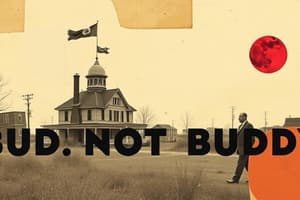Podcast
Questions and Answers
Why did Bud get in a fight with his foster brother?
Why did Bud get in a fight with his foster brother?
Because he called him Buddy
Where did Mr. Amos make Bud sleep?
Where did Mr. Amos make Bud sleep?
In the shed
Who does Bud think is his father?
Who does Bud think is his father?
Herman E. Calloway
Explain Bud's rule of lying.
Explain Bud's rule of lying.
Why does Bud not beg and plead to be let out of the shed?
Why does Bud not beg and plead to be let out of the shed?
Why do you think Bud doesn't cry anymore?
Why do you think Bud doesn't cry anymore?
Who is Bud mad at? Why?
Who is Bud mad at? Why?
What do you think Bud is going to do?
What do you think Bud is going to do?
Explain the saying 'he who laughs last laughs best.'
Explain the saying 'he who laughs last laughs best.'
Do you think a new door will be opening for Bud? Explain.
Do you think a new door will be opening for Bud? Explain.
Why do you think the couple pretended Bud was their son in the food line?
Why do you think the couple pretended Bud was their son in the food line?
Explain the irony behind the 'No Place Like America Today' billboard being placed where it was.
Explain the irony behind the 'No Place Like America Today' billboard being placed where it was.
Flashcards are hidden until you start studying
Study Notes
Chapter 1-6 Summary
- Bud fights with his foster brother due to being called "Buddy," highlighting his desire for identity and respect.
- Mr. Amos confines Bud to a shed, illustrating neglect and a lack of compassion in his foster environment.
- Bud believes Herman E. Calloway is his father, indicating his longing for familial connection and a sense of belonging.
- Bud's philosophy on lying emphasizes the survival skills he has developed; he views lying as a necessary skill in a harsh world.
- Rather than beg for release from the shed, Bud chooses silence to hide his fear, demonstrating his resilience and self-control.
- Bud's inability to cry reflects his emotional desensitization, a coping mechanism for the pain and sadness he has endured.
- He harbors anger towards the Amos family and himself, stemming from a misunderstanding involving a wasp nest, showcasing his frustration and internal conflict.
- Bud plots revenge against the Amos's, fueled by his desire for justice and to reclaim his power.
- "He who laughs last laughs best" encapsulates the message that ultimate success and satisfaction come to those who endure hardships.
- A potential new opportunity for Bud is suggested, as he feels a sense of hope, indicating character growth and optimism.
- A couple pretends Bud is their son in a food line to ensure he receives food, highlighting the desperate measures people take in difficult circumstances.
- Irony is present in the "No Place Like America Today" billboard, contrasting the imagery of wealth with the reality of poverty faced by those in line, emphasizing societal inequalities.
Studying That Suits You
Use AI to generate personalized quizzes and flashcards to suit your learning preferences.




